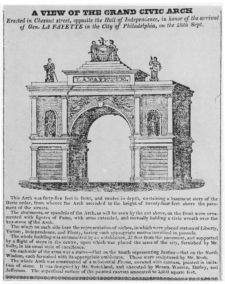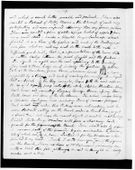Charles Willson Peale
[http://www.nga.gov/content/ngaweb/research/casva/research-projects.html A Project of the National Gallery of Art, Center for Advanced Study in the Visual Arts ]
History
Texts
- December 8, 1783, describing his triumphal arch erected in Philadelphia, Pa. (quoted in Sellers 1969: 196) [1]
- “I am at this time employed in painting a transparent triumphal Arch for the Public rejoicings on the peace, and very much hurried.” [Fig. 1]
- c. 1825, describing Philadelphia, Pa. (Miller, Hart, and Ward, eds., 2000: 5:91) [2]
- “When Peace was concluded between Great Britain & the united States of America, President Dickenson and the Executive Counsil employed Peale to paint a Triumphal Arch in transparent Colours. It consisted of three arches, the Center Arch was 20 feet high, and the side arches each 15 feet high, and the whole length extended nearly to the width of Market street, and it was 46 feet high, independant of the statues of the 4 cardenal Virtues larger than human figures. The architecture was of the Ionic order, ornamented with reaths of Flowers, in festoons and winding round the Columes. It was also ornamented in sundry parts of the building as follows[:]
- “A figure of Peace, represented in a beautiful female figure, and various attendants amidst the Clouds. These were to be lighted by lights placed behind the clouds and out of the sight of the spectators, and doubtless would have had a most pleasing affect in passing down from the Top of the Presidents House to the Triumphal Arch, with a fuse in the hand of Peace, which was to be directed to a fuse which would light 1100 Lamps, & illuminate the whole of the Triumphal Arch in a minute.”
- “below the Green house he made a round bason to receive the Water from the cave back of it—and from the fish-pond near the spring-house, to this bason in the Garden is a fall of 15 feet, and
in order to have a fountain in the Bason he put log-pipes under ground, and thus had a jet of 13 feet high but of small diameter, in order that it might constantly [be] rising. but unfortunately he make the bore of his logs only of one inch diameter, the consequence was that Frogs in two instances got into the bore of the logs and not being able to pass through all the joints, stopped the water, of course to free the passage of the logs, gave much labour. had these things been foreseen, trouble might have been prevented, by making the bore of the logs of a greater diameter, with other provisions to keep the passage free.”
Images
- 1984.jpg
Mary White Morris, c. 1782.
- 0569.jpg
Garden Gate at "Belfield," c. 1810-1817.
References
Notes
- ↑ Charles Coleman Sellers, "Charles Willson Peale with Patron and Populace," Transactions of the American Philosophical Society 59, no. 3. (1969): p. 103, view on Zotero.
- ↑ 2.0 2.1 Lillian B. Miller, and et al, eds., The Selected Papers of Charles Willson Peale and His Family: Charles Willson Peale: Artist in Revolutionary America, 1735-1791. Vol. 1; Charles Willson Peale, Artist as Museum Keeper, 1791-1810. Vol 2, Pts. 1-2; The Belfield Farm Years, 1810-1820. Vol. 3; The Autobiography of Charles Willson Peale. Vol. 5. (New Haven, Conn.: Yale University Press, 1983–2000), view on Zotero.















